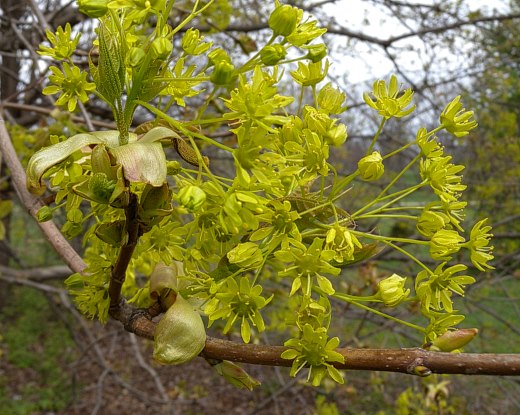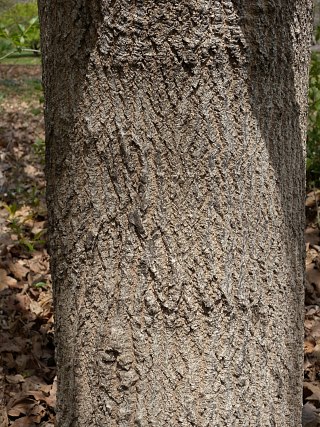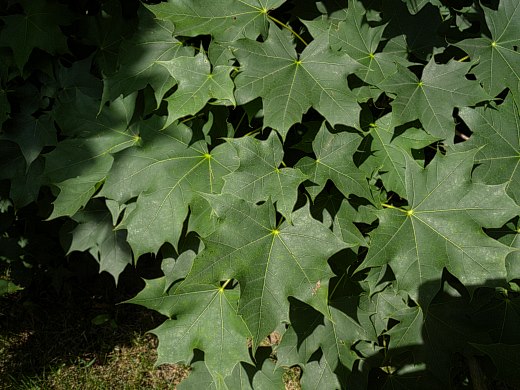Description: This tree is 40-80' tall, forming a single trunk up to 2½' across and a globoid to ovoid crown. The trunk bark of mature trees consists of gray ridges that are separated by narrow brown furrows; sometimes the ridges are interlacing. Branch bark is more smooth and gray, while twigs are greenish brown to brown with scattered white lenticels. Pairs of opposite leaves occur along the twigs. Individual leaves are 3-6" long and 3½-7" wide; they are palmately lobed (usually 5 lobes). Each lobe is rather broad at the base, tapering gradually to a pointed tip; there are usually 1-2 large pointed teeth on either side of each lobe. The upper leaf surface is medium to dark green, while the lower surface is slightly more pale; both surfaces are hairless. The slender petioles are light green to pale yellow, terete, and glabrous; they are as long as, or slightly longer than, the adjoining leaf blades.

Norway Maple can
be monoecious or dioecious, producing male (staminate) flowers and
female (pistillate) flowers on either the same or separate trees. Both
types of flowers are produced in umbel-like clusters spanning 2-3"
across; each cluster consists of 10-30 flowers. The slender stalks of
each corymb are green and either hairless or glandular-hairy.
Individual male and female flowers span about 8 mm. (a little less than
1/3") across; each flower has 5 sepals, 5 petals, and a circular
central disk that are greenish yellow. Male flowers have 8 fertile
stamens, while female flowers have a green pistil with a pair of styles
and 8 sterile stamens. Each pistil has a pair of basal wings. The
blooming period occurs during mid-spring shortly before, or at the same
time as, the unfolding of the leaves. Fertile pistillate flowers are
replaced by pairs of samaras (seeds with elongated wings) that are
1½-2" long. The samaras are joined together at the base, forming an
angle that is a little less than 180°. Each pair of samaras dangles
from a slender pedicel. The samaras become mature during the fall and
turn brown; they are distributed by the wind. The woody root system is
shallow and widely branching. The deciduous leaves usually turn yellow
in the fall.
Cultivation:
Norway Maple prefers full sun to light shade, more or less mesic
conditions, and a fertile loam or clay-loam soil. It tolerates urban
pollution and compacted soil. Because the leafy crown casts a dense
shade, grass and other kinds of ground vegetation have difficulty
surviving underneath this tree. The fallen leaves also contain
phytotoxic chemicals that inhibit the growth and development of other
vegetation.

Range &
Habitat:
Norway Maple has occasionally naturalized in NE Illinois and probably a
few counties elsewhere (see Distribution
Map). It was introduced into North America from Eurasia as a
landscape tree. Habitats consist of areas along roads and vacant lots
in urban areas. Even though it may have the potential to be invasive,
this tree is often cultivated in such places as areas along streets,
lawns, and city parks.
Faunal Associations:
The flowers of Norway Maple are cross-pollinated primarily by bees;
honeybees and bumblebees have been observed to suck nectar from the
flowers (Wilhelm & Rericha, 2017). Insects that have been observed
to feed on the foliage and other parts of this tree include wood-boring
larvae of Chrysobothris femorata (Flat-headed Apple Tree Borer), Periphyllus lyropictus (Norway Maple Aphid), Phenacoccus acericola (Maple Mealybug), and larvae of the micromoth, Etainia sericopeza (Norway
Maple Seed Miner); see MacRae (1991), Pepper (1965), ScaleNet (2014),
and Wilhelm & Rericha (2017). In addition to these insects, many of
the insects that feed on other maples also feed on this maple. Like
other maples, the seeds of Norway Maple are eaten by some upland
gamebirds and granivorous songbirds. This includes such species as the
Northern Cardinal, Rose-breasted Grosbeak, Evening Grosbeak, Bobwhite
Quail, and Wild Turkey. The Bird Table
has a more complete list of bird species that use maples as a source of
food. Mammals also use maples as sources of food in various ways. For
example, the wood and bark of these trees are eaten by the American
Beaver and North American Porcupine, while the twigs and foliage are
eaten by the American Moose, Elk, and White-tailed Deer. Some smaller
mammals also eat the seeds; this includes the Prairie Vole, Meadow
Vole, White-footed Mouse, Eastern Gray Squirrel, Fox Squirrel, American
Red Squirrel, Eastern Chipmunk, and Cottontail Rabbit (Martin et al.,
1951/1961; Schneider et al., 2006; personal observation). Maples also
provide protective cover and nesting habitat for many species of birds,
bats, and other animals.
Photographic Location:
The Arboretum at the University of Illinois in Urbana, Illinois.

Comments: There are many cultivars of Norway Maple. Cultivars with unusual characteristics include those with dark purple leaves, variegated leaves, deeply divided feathery leaves, and a tall columnar crown. Because of the similarity of their leaves, it is possible to confuse the Norway Maple with the native Sugar Maple (Acer saccharum), which is also widely cultivated. For Norway Maple, when one of its petioles is broken off at the base, there should be some milky sap visible. In contrast, the petiole bases of Sugar Maple always exude a clear sap. Because they are designed to attract insect pollinators, the flowers of Norway Maple are more showy than those of Sugar Maple and their floral structures are quite distinct. The paired samaras of Norway Maple form nearly a 180º angle, while those of Sugar Maple are less divergent, forming a 90º angle approximately. Norway Maple also differs in the fall coloration of its leaves: they are usually yellow, while the leaves of Sugar Maple are more often orange to red.